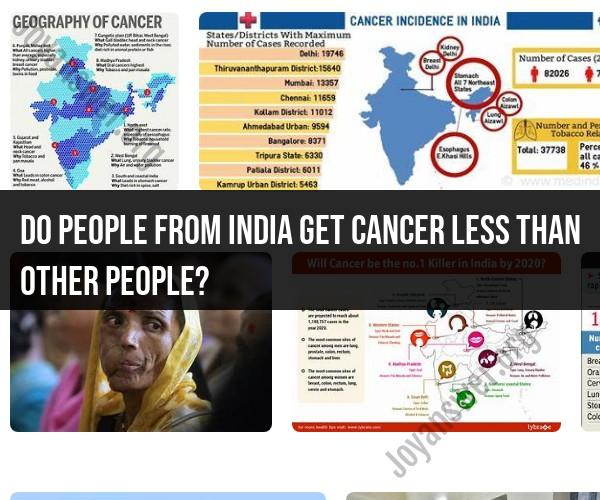Do people from India get cancer less than other people?
Cancer rates can vary by region and population due to a range of factors, including genetics, lifestyle, healthcare access, and environmental exposures. It's important to note that cancer is a complex disease, and its occurrence is influenced by various factors. Here are some key points to consider when exploring cancer rates in India:
Cancer Incidence in India:
Variation by Type: The incidence of specific types of cancer in India can vary. For example, certain cancers like oral, lung, and stomach cancer are relatively more common in India compared to other regions.
Geographic Variation: Cancer rates can vary significantly within India. Urban areas often have higher cancer rates than rural areas, which can be attributed to lifestyle factors, such as diet and tobacco use.
Tobacco Use: High rates of tobacco use, including smoking and smokeless tobacco products, are a significant factor in the prevalence of cancer in India. It is a leading cause of oral and lung cancers.
Environmental Exposures: Environmental factors, such as pollution and exposure to certain chemicals or toxins, can contribute to cancer risk.
Genetics: Genetic factors can also play a role in cancer risk. Some individuals may be genetically predisposed to certain types of cancer.
Infectious Agents: In some cases, cancers are caused by infectious agents, such as hepatitis B or human papillomavirus (HPV). Efforts to address and prevent these infections can impact cancer rates.
Preventive Measures:
India, like many countries, has been taking steps to address and reduce cancer rates. These measures include:
Tobacco Control: Implementing and enforcing tobacco control policies, including higher taxes on tobacco products, graphic health warnings, and smoking bans.
Cancer Screening Programs: Expanding cancer screening and early detection programs to identify and treat cancer at earlier stages.
Vaccination: Promoting vaccination programs to prevent cancers associated with infectious agents, such as HPV vaccination for cervical cancer prevention.
Lifestyle Changes: Promoting healthier lifestyles, including balanced diets, regular physical activity, and reduced exposure to environmental risk factors.
Improved Healthcare Access: Expanding healthcare access and infrastructure to provide early diagnosis and better treatment options for cancer patients.
It's important to recognize that cancer is a complex and multifactorial disease. While some types of cancer may be more prevalent in India, efforts are ongoing to reduce cancer incidence and improve cancer care in the country. Regular screenings, early detection, and cancer prevention measures are crucial in reducing the burden of cancer.
Ultimately, whether people in India get cancer less than other people depends on multiple factors, and the rates can vary widely by region and population group within the country. The data should be analyzed in a nuanced manner to understand the specific factors contributing to cancer rates in different areas of India.
Cancer Incidence in India: Understanding the Statistics
According to the Indian Council of Medical Research (ICMR), cancer is the second leading cause of death in India, after cardiovascular diseases. The ICMR estimates that there are over 1.3 million new cancer cases and over 736,000 cancer deaths in India each year.
The most common types of cancer in India are:
- Breast cancer
- Lung cancer
- Oral cancer
- Cervical cancer
- Stomach cancer
Cancer incidence rates in India vary depending on the region, age, and gender. For example, cancer rates are higher in urban areas than in rural areas, and cancer rates increase with age.
Factors Influencing Cancer Rates in Different Populations
There are a number of factors that can influence cancer rates in different populations, including:
- Age: Cancer is more common in older adults.
- Gender: Some types of cancer are more common in men than in women, and vice versa.
- Genetics: Some people are more genetically predisposed to cancer than others.
- Lifestyle: Certain lifestyle factors, such as smoking, tobacco use, and excessive alcohol consumption, can increase the risk of cancer.
- Environmental factors: Exposure to certain environmental toxins, such as air pollution and radiation, can also increase the risk of cancer.
Investigating the Relationship Between Geography and Cancer Risk
There is a growing body of research that suggests that there is a relationship between geography and cancer risk. For example, studies have shown that people who live in urban areas are more likely to develop certain types of cancer, such as lung cancer and bladder cancer.
There are a number of possible explanations for this relationship. One possibility is that people who live in urban areas are more likely to be exposed to certain environmental toxins. Another possibility is that people who live in urban areas are more likely to have unhealthy lifestyles, such as smoking and eating a poor diet.
Public Health Efforts to Address Cancer in India
The Indian government is taking a number of steps to address cancer in the country. These efforts include:
- Raising awareness of cancer: The government is raising awareness of cancer through public health campaigns and educational programs.
- Improving access to cancer screening and treatment: The government is expanding access to cancer screening and treatment services through government hospitals and clinics.
- Supporting cancer research: The government is supporting cancer research through funding and grants.
Dispelling Myths About Cancer Incidence in India
There are a number of myths about cancer incidence in India. One common myth is that cancer is more common in developed countries than in developing countries. This is not true. Cancer is a global problem, and cancer rates are increasing in all countries, including India.
Another common myth is that cancer is a death sentence. This is also not true. Many types of cancer are treatable, and survival rates are improving all the time.
If you have any concerns about cancer, it is important to talk to your doctor. Your doctor can help you understand your risk of cancer and can provide you with information on cancer screening and prevention.













